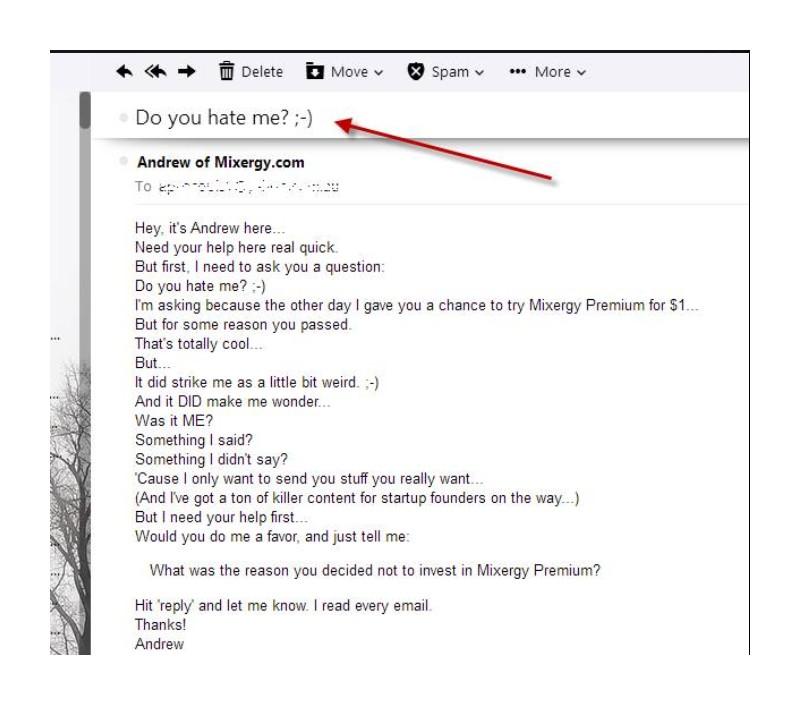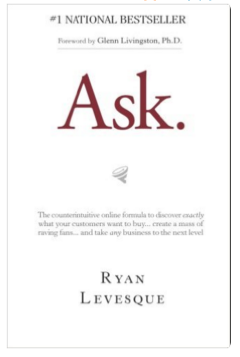3 Easy Feedback Emails to Turn Subscribers into Rabid Fans
Ryan Levesque
I’m a big fan of simple solutions.
I’m also a big fan of looking for the 80/20: the 20% effort that will yield you 80% of your results.
For me, email is definitely an 80/20 activity.
As you’re looking to build your audience and grow your business, emails—specifically feedback emails—are one of the most important paths of communication that you have. I love email because it’s relatively easy to test something new and see significant results.
It’s also a great way to build a strong relationship with your audience.
(I learned a ton about this from my buddy Andre Chaperon. His Autoresponder Madness course is still one of the best email marketing courses out there.)
Some marketers tend to think of email as a one-way street: you send autoresponders or broadcasts, your audience reads them, and they either click… or they don’t.
I’m not sure why this myth is so widespread, since I think email is possibly the BEST way to get feedback from your market.
Well, it’s actually quite simple (I told you I’m a fan of simple solutions)… just ASK.
Below, I’ve share three simple emails that get a huge response from every list I send them to.
These emails are simple ways to get specific types of feedback from your audience with the added bonus of making your audience instantly more loyal to you.
Ready to dive in? Let’s get started:
Email #1: The Initial Check-in

This email is the first “check-in” that you have with a customer.
Once you send them the access details for their product, or their “free gift” for opting in to your list, you send out a separate email to check that they received it.
I actually discovered this approach by accident in the memory improvement market when I genuinely wanted to know if people were receiving the free “Memory Improvement Kit” I was sending as part of my RocketMemory business.
When the responses started flooding in, I decided to respond back to some of them. And that’s when I discovered the power of this simple approach.
Here’s how it works
- Compose an email to go out automatically 2 hours after the delivery of your product or lead magnet on Day 0.
- Here’s the text: “Hey, FIRSTNAME. I shot you a free PDF a few minutes ago. Just want to make sure that I sent it to the right email address. Can you just *HIT REPLY* and let me know if you got it? Thanks, Your Name”
- When they reply, send another quick email with the following text: “Awesome, thanks for letting me know, FIRSTNAME. One more quick question: Not sure you had a chance to check it out yet, but is there something specific that you’d like me to cover in the upcoming weeks? In other words, what’s the biggest challenge that you’re facing right now that you’d like me to talk about?”
- When they reply to this email, that’s when you strike GOLD.
This simple email exchange is really powerful for a few reasons.
The first email is what I like to call a “Micro-Commitment.” It’s a small action that makes it easier to take other actions.
It’s the first easy step into your world.
The inspiration for Micro-Commitments comes from the teachings of Kaizen, and the book One Small Step Can Change Your Life: The Kaizen Way by Robert Maurer, PhD. (This book was hugely influential as I was developing the Ask Formula.)
When they reply to the second email, that’s when…
Three awesome things happen
- It establishes a relationship and lets your customer/reader know that there’s a real person listening to their feedback, reading their emails, and interacting with them.
- You get instant feedback on your product, your audience’s interests and challenges, and what they’d like to know more about.
- When someone replies to your email it automatically puts you on their whitelist, which means that this is one of the BEST ways to ensure that your future emails get delivered without actually asking them to whitelist you.
Is this going to create a flood of emails? Well, if it works as planned, then the answer is YES. And that’s a good thing.
The beautiful thing about this is that you can turn it on and off as you like, so you don’t get overwhelmed.
And if you’re getting hundreds of email responses per day, then that’s a sign that you might be ready to hire someone to help you handle that flood of emails since each email represents a potential customer.
Another benefit of this “check-in” technique is that you can use it at any point to get feedback on something specific.
I recently experimented with different content formats in my emails: short audios, longer audios, and videos.
In a P.S. of an email, I asked, “What do you think of the new formats we’ve been using? Just *HIT REPLY* and let me know.”
We got dozens of replies, and I read through every single one which helped us decide which formats to use going forward. (The answer in this particular instance is that there was no overwhelming preference, which means we’re going to stick with a mix of different content formats.)
Email #2: The DYHM (“Do You Hate Me?”) Email
This email is part of the Ask Formula that I lay out in my book, Ask.
While the title of this email might be a little shocking, that’s why it works so well.
The main goal of this email is to ASK your audience why they didn’t buy your product or take you up on a special offer.
The “Do You Hate Me” email survey should be sent out after a launch or a special product offer to the people who didn’t buy.
Here’s how the email might look
Subject Line: Do You Hate Me? 😉
“Hi Firstname,
I need your help real quick, but first I need to ask you a question.
Do you hate me? :-) *
I’m asking because the other day I gave you a chance to get OFFER XYZ, but for some reason you passed.
Did I not do a good job of explaining something?
Did I not do a good job of touching on a specific hot point that matters to you?
Maybe it was because of me…
Something I said, something I didn’t say.
In other words, do you hate me?
If you could just do me a favor and click on the link below to let me know…
What was the biggest reason you decided not to try XYZ product/service?
It would mean the world to me.
Here’s the link:
===>Click here to let us know
*Note: The 🙂 is important to let your reader know what you’re saying is “tongue in cheek.”
This leads to a one-question, open-ended survey form, or you can simply ask them to *HIT REPLY* to the email.
Now, while the “hate” part is tongue in cheek, people feel the urge to respond to this email.
Even the suggestion that they might hate you makes them uncomfortable, and this often prompts your audience to leave you long and detailed answers in an attempt to show you that, no, they don’t really hate you at all.
Once you have the responses from your audience…
You can use this information in three ways
- Answer the objections in a live Q&A webinar. The webinar can then be recorded and used again in your marketing.
- If you don’t want to do a webinar, you can use these to create an FAQ email which becomes part of your autoresponder sequence.
- Use the feedback to tweak your sales pages and your content to answer these objections.
The Do You Hate Me email might be a little scary to send at first, and you do have to know your audience (I like to use the winky emoticon to lighten it up for certain markets), but the feedback that you get will be worth it. I promise.)
And there are plenty of smart marketers using this technique, too. Just a few that I can think of off the top of my head are Selena Soo, software company HEYO and Andrew Warner of Mixergy (in fact, you can see Mixergy’s DYHM email right here):

Email #3: Pivot Survey Email

The third email is all about letting your audience choose where they want to go next.
In the Ask Formula sequence, this email comes after the Do You Hate Me email. Although you can also use it to get ideas for new blog or podcast topics, or product creation.
The email is simple and might read something like this
“I understand that XYZ product wasn’t quite right for everyone. I appreciate your time and attention, and I’d still like to help you.
We have several options as to where we can go next.
Which of the following best describes what you’re most interested in covering next?
( ) How to do X
( ) How to do Y
( ) How to do Z
Choose the option that you’d like to focus on next, and we’ll shift gears and begin covering that subject in more detail.”
You can use this survey to decide what content to create next, or if you already have the products in place, you can automatically start sending new content and offers based on the response.
People who respond to this survey and then receive a follow-up based on their response will feel that their feedback has been listened to and will increase the rapport you have with your audience.
“3 Easy Feedback Emails to Turn Subscribers into Rabid Fans by #RyanLevesque”
Tweet Me
Each of these 3 emails is simple to implement.
Each one can potentially double or even triple your response.
So why aren’t more people using these kinds of feedback emails? Why are we so afraid to simply ASK our audience what they want?
Once you get into the habit of asking, you’ll save yourself time, money, and effort on guessing what your audience wants to hear and spend more time giving it to them.
Leveraging these three emails is a great place to start, but if you really want to create a mass of raving fans, you’ll want to read about the full Ask Formula, including the full email sequences that I use in my follow-up marketing, and the two other surveys that happen before the ones discussed here.
It’s your turn. Are you afraid to ASK? Do you know why? Or maybe you already have. If so, what kind of responses did you get from your audience?

mridea
I noticed a mention of a download link to a 26 page excerpt from your book, but no actual link. Did I miss something?
Lexi Rodrigo
Hi Jim, It looks like that offer is no longer available. I’ve edited the post to remove that mention.
Jessica Oman
I don’t like the Do You Hate Me phrasing, but the concept is good – it shows that by asking for feedback immediately, you intend to listen to your audience and take action based on what they say.
Yes, the emoticon lightens it up, but I’m a bigger fan of using the right words to convey the message, rather than relying on silly combinations of punctuation marks to get the point across. Hell, I even avoid exclamation points as much as possible.
Tracey Hainrick
I like to join this program. I have a question how can I
chat on you guys in facebook, cause I have no one.
Alastair McDermott
I don’t like the DYHM email because it feels a bit forced to me – it’s definitely not me 🙂
Also I think it’s a bit like using a “personal” story in an autoresponder that 12 other guys are using. It’s going to hit saturation sometime soon.
Virginia
Ryan: I like the follow-up of two e-mails after the initial contact. It reinforces your name for them. I agree about not linking the “hate me” format. When I get them now I immediately delete – I don’t care what the offer might be. To me it’s not cute or clever or funny. It’s negative. It’s like laying a guilt trip. Asking for help is always useful; we want to feel that our opinion is desired.
Pat
I’m afraid of the DYHM email. Are there alternatives?
I’m sure this works in many niches, but in coaching and personal development this line seems to step outside of the “I’m the absolute best person to help you” positioning. If you don’t buy my product right away–“I’m a fragile pile of nerves needing consolation from anyone, even complete strangers. Don’t say you hate me, I hate that”…(drivel, drivel, drivel).
Nicki Kelly
Hi Pat,
In the past I used an email subject line which worked well for me. It was headed:
“What went wrong?!!” The body copy was similar to the one above, talking about an offer that was not taken up by the recipient. My email was very genuine because I truly wanted an opportunity to overcome any objections the potential customer might have had. I got many meaningful responses allowing me to engage in further email conversations which often led to a sale. These type of emails are a great way to find out ‘what went wrong’ so you can do better next time.